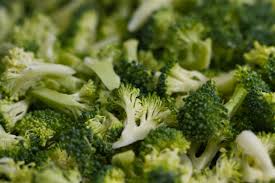Eat your Broccoli!: Learn why this much-maligned food is more than it seems!
Do you remember being told to “eat your broccoli” as a child? It’s no secret that most children want to run in the opposite direction at the mere sight of broccoli because of its “stinky” smell, bright green appearance, and bitter taste. Broccoli has gotten a bad reputation over the years, but based on current research, it seems like it’s time for broccoli to make a comeback! And here’s why…
Broccoli is a cruciferous vegetable, otherwise known as Brassica vegetable. Other Brassica vegetables include cauliflower, mustard greens, turnips, Brussels sprouts, collard greens, kale, and cabbage. Brassica vegetables contain a compound called sulforaphane. Sulforaphane is a plant chemical with powerful health benefits that range from decreased risk of death from any cause to improving cognitive function in patients with thought and behavior disorders. Sulforaphane’s main mechanism of action is by increasing glutathione production, otherwise known as the “mother of all antioxidants”. Thus, sulforaphane has extraordinary antioxidant potential in the body!
Sulforaphane is found in Brassica vegetables that contain high levels of glucoraphanin. What is glucoraphanin you may ask? Glucoraphanin is a plant molecule naturally present in Brassica vegetables that is responsible for their pungent smell. Glucoraphanin is important because it is the building block for sulforaphane production and is associated with decreased risk for thought disorders like schizophrenia1, cancer2, cardiovascular disease3, autism4, Alzheimer’s, and Parkinson’s disease5. Sulforaphane has also shown to be beneficial in reducing symptoms and severity of chronic skin conditions, like eczema6.
How does sulforaphane lower the risk for chronic disease? Great question! Sulforaphane works by targeting and binding to DNA sequences that are responsible for inflammation and reducing their expression2,3,6. In addition to reducing inflammation, sulforaphane increases the production of powerful antioxidants like glutathione2. Glutathione then acts like a magnet, grabbing toxins and free radicals from the body and delivering them to the colon to be excreted in the feces and prevent them from damaging tissue.
Research shows that one of the underlying causes of schizophrenia may be high levels of oxidative stress. In a pilot study, supplementation with sulforaphane-rich broccoli sprout extract improved cognitive deficits in patients with schizophrenia7. Furthermore, there’s evidence that shows that people with neuropsychiatric disorders have low levels of circulating glutathione, thus suggesting a potential role for sulforaphane in psychological symptom improvement.
Of all the Brassica vegetables, broccoli sprouts have the highest levels of glucoraphanin which means they have the highest potential to produce sulforaphane. In decreasing order, Brussels sprouts, mustard greens, turnips, kale, watercress, kohlrabi, red cabbage, broccoli, horseradish, cauliflower, and bok choy, also have the potential to produce sulforaphane8.
How do you optimize sulforaphane production to get the most antioxidant potential from Brassica vegetables? This is where glucoraphanin comes into play! Sulforaphane is produced by a chemical reaction between glucoraphanin and myrosinase, an enzyme that is only activated only when you chop or chew the vegetable. Unfortunately, boiling, blanching, roasting, or steaming Brassica vegetables destroys myrosinase activity which wrecks its sulforaphane potential. Luckily, researchers have discovered a way around this. Raw ground mustard seeds contain myrosinase, so adding them to your favorite cooked crucifers is enough to offset the antioxidant potential lost during cooking and increases sulforaphane production by almost fourfold in humans9!
Eat your broccoli and your other vegetables. If you would like more guidance on how to get the most out of the foods you eat and capitalize the power of broccoli, please contact Specialized Therapy Associates at (201)-488-6678 to make an appointment with one of our functional nutritionists. You can also visit us online at Specialized Therapy. Together, we can achieve your ultimate mind-body balance.
By Taylor Groff, MS Functional Nutritionist
References:
- Shiina A, Kanahara N, Sasaki T, et al. An Open Study of Sulforaphane-rich Broccoli Sprout Extract in Patients with Schizophrenia. Clin Psychopharmacol Neurosci. 2015;13(1):62-67. doi:10.9758/cpn.2015.13.1.62
- Houghton CA. Sulforaphane: Its “Coming of Age” as a Clinically Relevant Nutraceutical in the Prevention and Treatment of Chronic Disease. Oxid Med Cell Longev. 2019;2019:2716870. Published 2019 Oct 14. doi:10.1155/2019/2716870
- Bai Y, Wang X, Zhao S, Ma C, Cui J, Zheng Y. Sulforaphane Protects against Cardiovascular Disease via Nrf2 Activation. Oxid Med Cell Longev. 2015;2015:407580. doi:10.1155/2015/407580
- Klomparens EA, Ding Y. The neuroprotective mechanisms and effects of sulforaphane. Brain Circ. 2019;5(2):74-83. doi:10.4103/bc.bc_7_19
- Sun Y, Yang T, Mao L, Zhang F. Sulforaphane Protects against Brain Diseases: Roles of Cytoprotective Enzymes. Austin J Cerebrovasc Dis Stroke. 2017;4(1):1054. doi:10.26420/austinjcerebrovascdisstroke.2017.1054
- Wu W, Peng G, Yang F, Zhang Y, Mu Z, Han X. Sulforaphane has a therapeutic effect in an atopic dermatitis murine model and activates the Nrf2/HO 1 axis. Mol Med Rep. 2019;20(2):1761-1771. doi:10.3892/mmr.2019.10405
- Shiina A, Kanahara N, Sasaki T, et al. An Open Study of Sulforaphane-rich Broccoli Sprout Extract in Patients with Schizophrenia. Clin Psychopharmacol Neurosci. 2015;13(1):62-67. doi:10.9758/cpn.2015.13.1.62
- McNaughton, S., & Marks, G. (2003). Development of a food composition database for the estimation of dietary intakes of glucosinolates, the biologically active constituents of cruciferous vegetables. British Journal of Nutrition, 90(3), 687-697. doi:10.1079/BJN2003917
- Okunade O, Niranjan K, Ghawi SK, Kuhnle G, Methven L. Supplementation of the Diet by Exogenous Myrosinase via Mustard Seeds to Increase the Bioavailability of Sulforaphane in Healthy Human Subjects after the Consumption of Cooked Broccoli. Mol Nutr Food Res. 2018;62(18):e1700980. doi:10.1002/mnfr.201700980


